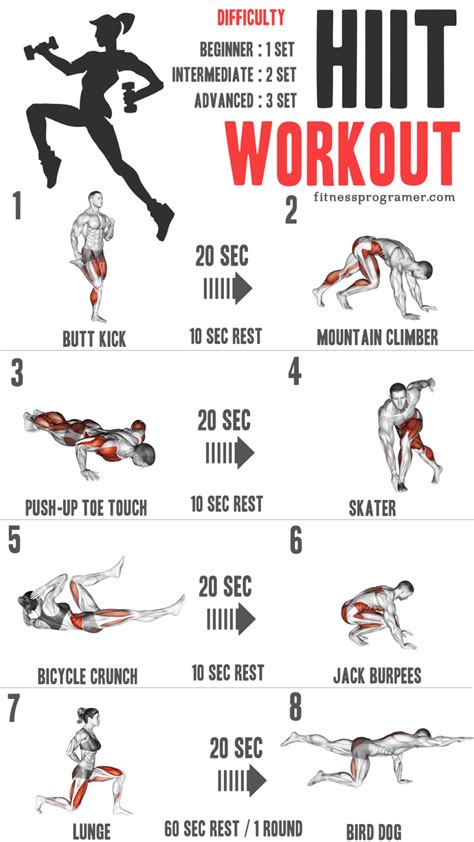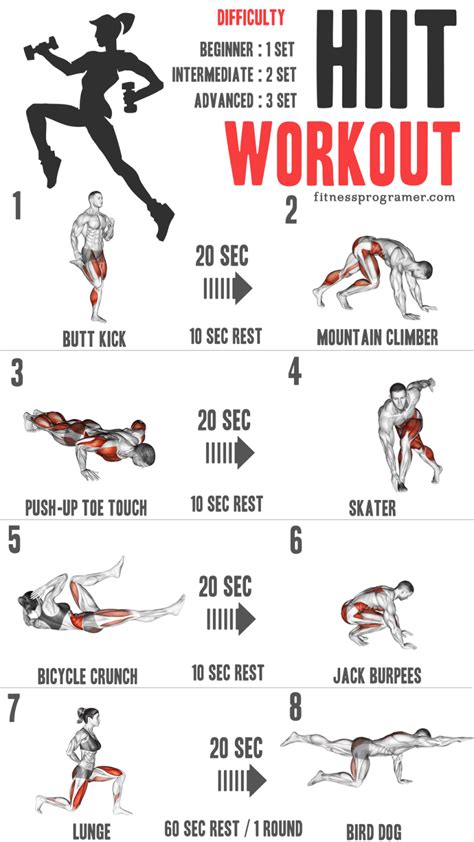Intro
Boost fitness with a High Interval Workout Routine, incorporating intense cardio exercises, strength training, and aerobic workouts for maximum calorie burn and weight loss, improving endurance and overall physical health.
The world of fitness is constantly evolving, with new trends and techniques emerging all the time. One approach that has gained significant attention in recent years is the High-Interval Workout Routine, also known as HIIT. This type of training involves short bursts of intense exercise followed by brief periods of rest, and it has been shown to have numerous benefits for cardiovascular health, weight loss, and overall fitness. In this article, we will delve into the world of HIIT, exploring its benefits, working mechanisms, and providing practical examples and tips for incorporating it into your workout routine.
The importance of HIIT cannot be overstated. Traditional steady-state cardio exercises, such as jogging or cycling, can be time-consuming and may not be as effective for weight loss or improving cardiovascular health. HIIT, on the other hand, offers a time-efficient and highly effective way to improve your fitness, burning calories and boosting your metabolism in a shorter amount of time. Whether you're a seasoned athlete or just starting out on your fitness journey, HIIT is an excellent way to challenge yourself, increase your endurance, and achieve your goals.
For those who are new to HIIT, it's essential to understand how it works. The basic principle involves alternating between periods of high-intensity exercise and short periods of rest or low-intensity exercise. This cycle is repeated for a specified amount of time, typically between 15-30 minutes. The high-intensity periods are designed to push your body to its limits, while the rest periods allow you to recover and prepare for the next burst of exercise. This type of training has been shown to improve cardiovascular health, increase speed and agility, and boost metabolism, making it an excellent addition to any workout routine.
Benefits of High Interval Workout Routine

Improved Cardiovascular Health
One of the most significant benefits of HIIT is its ability to improve cardiovascular health. The high-intensity periods of exercise help to strengthen the heart and lungs, increasing cardiovascular function and reducing the risk of heart disease. HIIT has also been shown to improve blood flow and reduce blood pressure, making it an excellent way to manage hypertension and other cardiovascular conditions.Increased Caloric Burn
HIIT is also an excellent way to burn calories and manage weight. The high-intensity periods of exercise help to increase the body's metabolic rate, burning calories and fat more efficiently. Additionally, HIIT has been shown to improve insulin sensitivity, reducing the risk of type 2 diabetes and other metabolic disorders.Working Mechanisms of High Interval Workout Routine

Physiological Responses
The physiological responses to HIIT are numerous and complex. During the high-intensity periods of exercise, the body's heart rate and blood pressure increase, delivering more oxygen and nutrients to the muscles. The muscles, in turn, respond by contracting more forcefully, generating more power and speed. The rest periods, on the other hand, allow the body to recover, reducing heart rate and blood pressure, and replenishing energy stores.Metabolic Responses
The metabolic responses to HIIT are also significant. During the high-intensity periods of exercise, the body's metabolic rate increases, burning more calories and fat. The rest periods, on the other hand, allow the body to recover, reducing metabolic rate and replenishing energy stores. This cycle of exercise and recovery helps to improve insulin sensitivity, reduce blood sugar levels, and boost metabolism.Steps to Incorporate High Interval Workout Routine

Example Workout Routine
Here's an example HIIT workout routine: * Warm up: 5 minutes of light cardio and stretching * Burpees: 3 sets of 10 reps, with 30 seconds rest between sets * Jump squats: 3 sets of 15 reps, with 30 seconds rest between sets * Mountain climbers: 3 sets of 20 reps, with 30 seconds rest between sets * Cool down: 5 minutes of stretching and foam rollingPractical Examples and Tips

Common Mistakes to Avoid
Here are some common mistakes to avoid when starting a HIIT workout routine: * Not warming up: Always warm up before starting your HIIT workout to prevent injury and improve performance. * Not listening to your body: Pay attention to your body and take regular breaks to avoid injury or burnout. * Not varying your exercises: Mix up your exercises and intervals to avoid plateaus and prevent overuse injuries.Conclusion and Next Steps

We hope you found this article informative and helpful. If you have any questions or comments, please don't hesitate to reach out. Share this article with your friends and family, and start your HIIT journey today!
What is HIIT and how does it work?
+HIIT stands for High-Interval Workout Routine, which involves short bursts of intense exercise followed by brief periods of rest. This type of training has been shown to improve cardiovascular health, increase caloric burn, and boost metabolism.
How do I get started with HIIT?
+To get started with HIIT, start with short intervals of 15-30 seconds, followed by 1-2 minutes of rest. Choose exercises that work multiple muscle groups at once, such as burpees, jump squats, or mountain climbers. Always warm up before starting your HIIT workout, and cool down afterwards to prevent injury and reduce muscle soreness.
What are the benefits of HIIT?
+The benefits of HIIT include improved cardiovascular health, increased caloric burn, and enhanced muscular endurance. HIIT has also been shown to improve insulin sensitivity, reduce blood pressure, and boost metabolism, making it an excellent way to manage weight and reduce the risk of chronic diseases.
